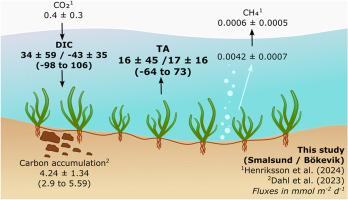现场测量揭示了寒温带海草草甸释放的碱度
IF 2.6
3区 地球科学
Q1 MARINE & FRESHWATER BIOLOGY
引用次数: 0
摘要
了解蓝碳生态系统的固碳潜力对于气候政策和指导恢复和保护工作具有重要意义。碱度的产生是一个经常被忽视的碳固存机制,特别是在海草草甸。在这里,我们量化了瑞典两个冷温带Zostera marina海草草甸的总碱度(TA)和溶解无机碳(DIC)通量,在高产季结束时使用24小时原位室孵育。海草草甸是相似的TA净来源(在Smalsund为16±45 mmol m−2 d−1,在Bökevik为17±16 mmol m−2 d−1),而DIC通量变化很大(在Smalsund为34±59 mmol m−2 d−1,在Bökevik为- 43±35 mmol m−2 d−1)。通量遵循与光合作用-呼吸周期一致的日循环。因此,海草草甸在白天局部改善了海洋酸化,但在夜间却没有。与红树林和盐沼相比,大量的二氧化碳吸收提供了更高的缓冲水平。TA通量与报告的地中海和热带海草草甸相当,但比红树林低16倍,比盐沼低5倍。这些寒温带海草的碱度产生超过土壤有机碳储量积累的四倍,可能有助于其固碳潜力,并保证将其纳入海草草甸碳收支。本文章由计算机程序翻译,如有差异,请以英文原文为准。

In-situ measurements reveal alkalinity release from cold-temperate seagrass meadows
Understanding the carbon sequestration potential of blue carbon ecosystems is important to inform climate policies and to guide restoration and protection efforts. Alkalinity generation is an often overlooked carbon sequestration mechanism, especially in seagrass meadows. Here, we quantified total alkalinity (TA) and dissolved inorganic carbon (DIC) fluxes in two cold-temperate Zostera marina seagrass meadows in Sweden using 24-h in-situ chamber incubations at the end of the high-productivity season. The seagrass meadows were similar net sources of TA (16 ± 45 mmol m−2 d−1 in Smalsund, 17 ± 16 mmol m−2 d−1 in Bökevik), whereas DIC fluxes were highly variable (34 ± 59 mmol m−2 d−1 in Smalsund, −43 ± 35 mmol m−2 d−1 in Bökevik). Fluxes followed a diurnal cycle consistent with photosynthesis-respiration cycles. As a result, seagrass meadows ameliorated ocean acidification locally during the day, but not during the night. The large CO2 uptake provided higher buffering levels compared to mangroves and saltmarshes. The TA fluxes were comparable to those reported for Mediterranean and tropical seagrass meadows, but 16-times lower than in mangrove forests and 5-times lower than in saltmarshes. Alkalinity generation in these cold-temperate seagrasses exceeded soil organic carbon stocks accumulation by fourfold, potentially contributing to their carbon sequestration potential and warranting inclusion in seagrass meadow carbon budgets.
求助全文
通过发布文献求助,成功后即可免费获取论文全文。
去求助
来源期刊
CiteScore
5.60
自引率
7.10%
发文量
374
审稿时长
9 months
期刊介绍:
Estuarine, Coastal and Shelf Science is an international multidisciplinary journal devoted to the analysis of saline water phenomena ranging from the outer edge of the continental shelf to the upper limits of the tidal zone. The journal provides a unique forum, unifying the multidisciplinary approaches to the study of the oceanography of estuaries, coastal zones, and continental shelf seas. It features original research papers, review papers and short communications treating such disciplines as zoology, botany, geology, sedimentology, physical oceanography.

 求助内容:
求助内容: 应助结果提醒方式:
应助结果提醒方式:


